

Teiko Hinuma, Curator Aomori Contemporary Art Centre Aomori Public College
Aomori Contemporary Art Centre (ACAC) is surrounded by the groves of red-pine trees on the hills of Moya, Aomori City. To accommodate residential, creative, and exhibition activities, ACAC is comprised of three buildings designed by the world renowned architect Tadao Ando: Exhibition Hall with two galleries (large and small); Creative Hall for woodwork, printing, and other creative activities; and Residential Hall for long-term residents. These buildings blend in the surrounding nature.
With a population of 300,000 people, Aomori City is one of the heaviest snowfall areas in the world. When the long and harsh winter ends, spring comes with flowers in full bloom and trees and grasses sprouting. After short summer passes, autumn colors leaves in red and yellow, and before long, winter comes again. Art exists with such seasonal changes in nature. Aomori is blessed with the wealth that can’t be found in big cities.

Appearance of ACAC
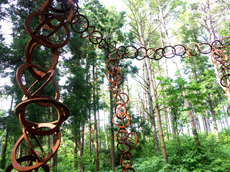
Garden path dotted with outside sculpture /Noe Aoki “Moya I”
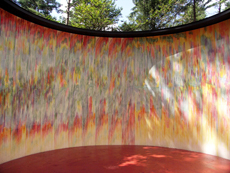
Garden path dotted with outside sculpture / Kei Tsuji “Aomori − Circle 2005”
AACAC was opened in December 2001 as a facility to commemorate the 100th anniversary of the establishment of the municipal organization of Aomori City. In addition to its main program Artist in Residence (AIR), it offers exhibitions, workshops, and lectures by resident artists to share creative activities with artists and citizen, with the purpose of establishing a new base for artistic activities with both international and local perspectives. At the establishment of ACAC, Goji Hamada, artist, was appointed as a director to navigate the preparation and promotion of the AIR project that had few precedents in Japan. His wealth of experiences and knowledge of AIR projects in Japan and abroad made Hamada the right person for the position, and his involvement in promotion of the program and design plan of the buildings with an artist’s point of view was an unprecedented, radical approach in cultural administration. In line with a recent trend toward government-citizen partnership and social participation, ACAC intended to be a forum for art-based civil activities. As the first instance of such collaboration, the pre-event in 2000 was commissioned to Aomori NPO Support Center, the first non-profit organization in the prefecture. At the official opening of ACAC in the following year, the core members of volunteers participated in the pre-event formed “AIRS (Artist-in-Residence Supporters)” . They are still voluntarily supporting resident artists in various ways.
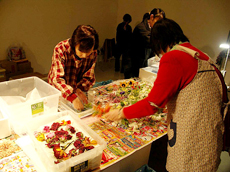
AIRS supporting production of cassette plants by Keisuke Yamaguchi
ACAC’s AIR provides three-month invitation programs twice a year, in spring and autumn. Artists are invited by recommendation in the spring program, whereas they are invited by open call in the autumn program. In both programs, exhibitions and exchange programs with citizens are held. Other programs include events and workshops for families during summer vacation and special workshops of woodwork and dance in winter (Picture 4) In its core activity AIR, artists relate to various elements such as environment, architecture, history, and climate, and express their interpretations in contemporary art. Citizens, on the other hand, encounter with new expressions and thoughts and rediscover the richness of their own community. It is expected to promote active participation in civil activities as well as to improve their hospitality by accepting artists as residents in their society. It will result in each citizen’s power of independence, or the power to live. Therefore, Artist-in-Residence program can be regarded as a cyclic society. The cross-border relationship between artists and the community via AIR is now creating a field with great potential.
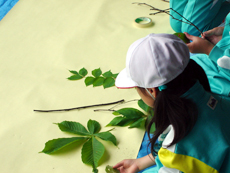
Workshop for children from local community using natural materials
Resident artists produce unique and vivid works. Paramodel*1 chosen Komakino Stone Circle, the ancient remains of late Jomon Period, for the stage of their well-known installation with Pla-Rail (railroad toy) to produce a site-specific work .

Paramodel working at Komakino stone circle
Tsuyoshi Higashijima*2 installed a huge 20-meter-wide painting in horseshoe-shaped Gallery A. It presented a spectacular space to interpret a relationship between picture and architecture.

Tsuyoshi Higashijima “Picture As A Promise”
Kei Tsuji*3, through fieldwork in riverhead and snow fields in Hakkoda mountains, left herself in the flow of water and red strings to reveal that human beings are subspecies of the nature. Toshikatsu Endo*4 brought out the energy of ancient Jomon period on the theme of “Sacrifice and Hollow”).
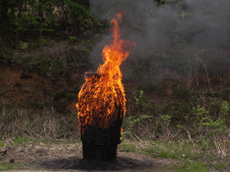
Open burning in Toshikatsu Endo’s work
The list of excellent works goes on and on. The energy that is deeply rooted in Aomori is magnet for artists, and their powers of expression impressed and thrilled us.
ACAC had been organizing many people and events as described above, and in 2009, its eighth year, it faced a turning point. As its adjoining Aomori Public College was converted into local independent corporate entity, ACAC was transferred from direct control of Aomori City to the entity of the college. Since its establishment, collaboration with the college was one of its basic concepts and future strategies. Aomori Public College is an institute to learn management and economy. It means that the college and ACAC become an organization where economy and art collaborate with each other. In addition to its main activity of Artist-in-Residence program, ACAC will also deal with new challenges such as contribution to local community through art and human resource development as a higher education institute. We are now taking a new step to utilize our accumulated knowledge and experiences as resources of local community.
*1──A unit of Yasuhiko Hayashi (born in 1971 in Higasi-Osaka City) and Yusuke Nakano (born in 1976 in Higashi-osaka City) started in 2001. Changed its name to Paramodel in 2003. On the theme of creating “para-model (combination of “paradise” and “pla-model”), they are producing works with various expressions and media including animation, paintings, 3Ds, photography, installation, etc. Their representative work of installation with Pla-rails produces a mysterious world like a maze or drawing in a huge site. Their main works are: ”Museum Summer Vacation: Paramodel Exhibition” at the Museum of Art, Kochi (2007); “Beautiful New World: Contemporary Visual Culture from Japan” organized by the Japan Foundation at Long March Space in Beijing, Guangdong Museum of Art in Guangzhou, China, and more.
*2──Born in Saga in 1960. Lives in Okayama. In 1986, graduated from Master’s Program, Fine Art (Western Style Painting) in Art and Design, University of Tsukuba. In 1988-90, studied at Department of Painting, Royal College of Art in London, UK. From 1990 to 1997, produced works in New York. Higashijima draws tranquil colors on overwhelmingly huge screens. His works pursue the wealth of paintings and highly appreciated. He received VOCA Award 1996 and The Most Promising Young Talent Prize, Fine Art Division of Gotoh Memorial Cultural Award in 1996. Higashijima is one of the leading contemporary Japanese artists.
*3──Born in Tokyo in 1953. In 1982, Tsuji started producing spatial works entitled “Wandering in Dreams” mainly with dyeing and textiles. Since 1986, she has been performing fieldwork and installation in Australian desert, Canadian woods, and waterfronts in Scottish islands using threads and cloths she dyed. Her main works are: exhibition at PICA (Perth Institute of Contemporary Arts), (Australia, 1989); The Suntory Prize ’98 − Challenges on Forms (Tokyo); Iwate Museum of Art opening exhibition “Works by Tsuji Kei” (Morioka, 2001) and more.
*4──Born in Gifu in 1950. Endo is one of the best sculptors representing post-war Japanese art. He started producing works in 1970s. His main subjects are fire, water, the earth and the sun; with these subjects, he has been consistently describing the primitive, mythical, and unconscious relationship between the world and mankind (or art) to face the abyss of spirit and impulse. Endo participated numerous exhibitions in Japan and abroad, including ”Documenta 8” (Kassel, 1987); The 48th Venice Biennale (1990); “Japanese Art after 1945: Scream against the Sky” Yokohama Museum of Art, Guggenheim Museum (1994); “A Perspective on Contemporary Art: Continuity/Transgression” The National Museum of Modern Art, Tokyo (2002).
[September 1, 2009]
2024.7.9Acasă la Hundorf Residency JournalArtist : Miyake Suzuko
2023.5.14AIR and I, 09 : Mentoring Artists for Women’s Art (MAWA) Residence Report